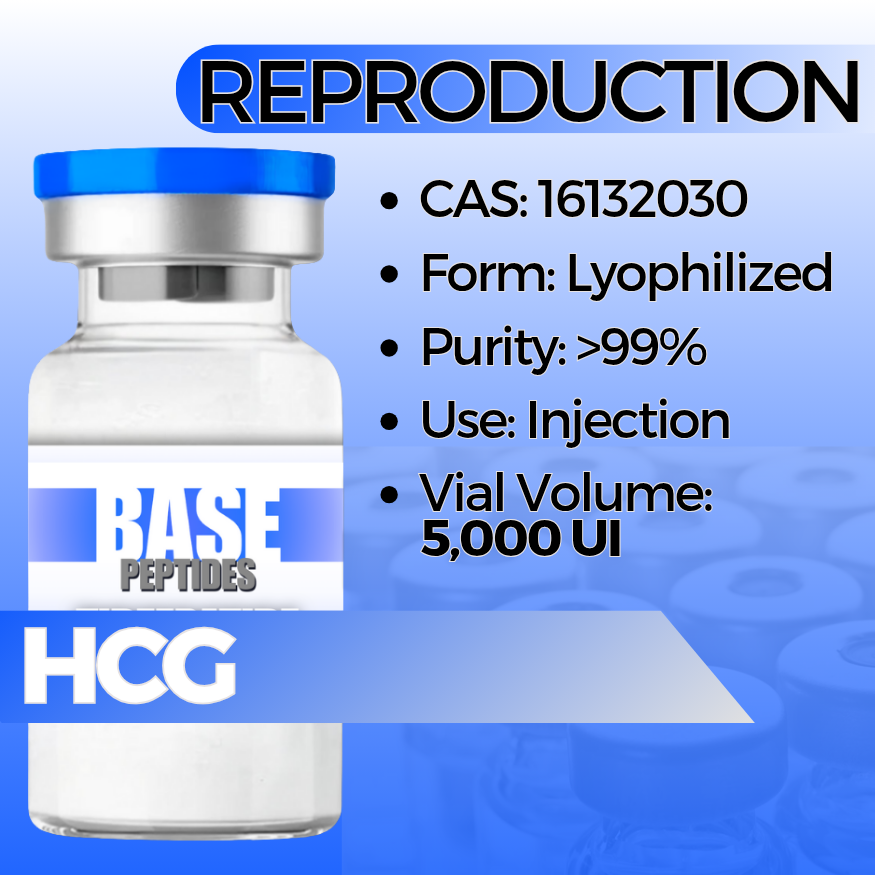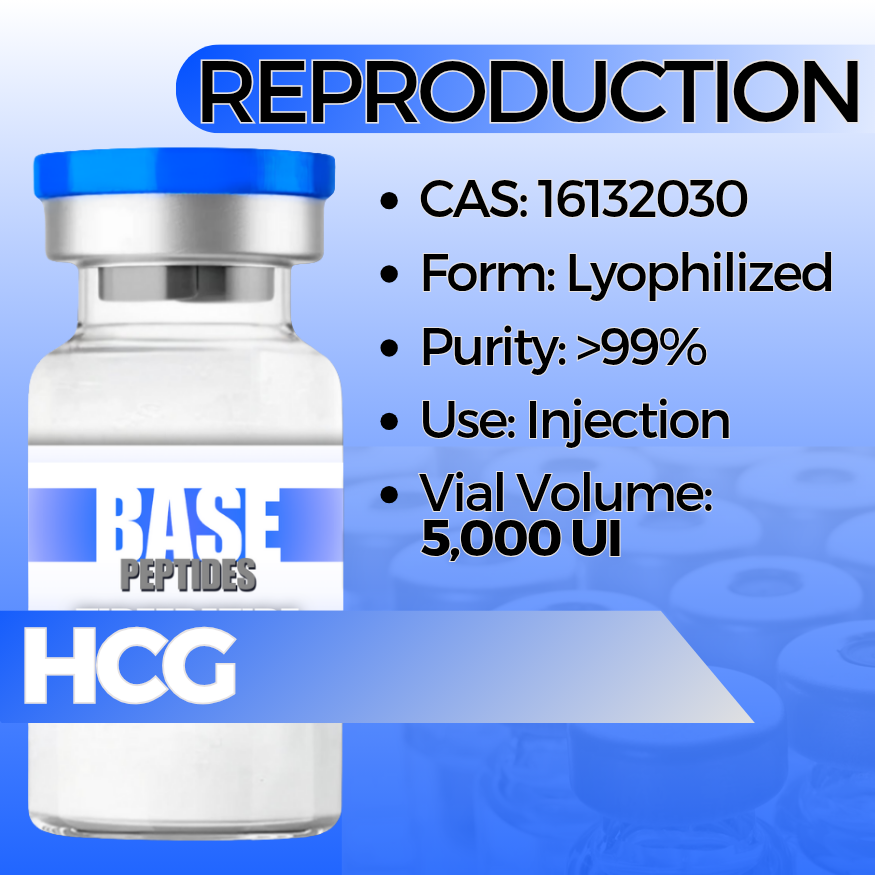HCG 5,000IU
HCG 5,000IU
Base Peptides are intended for licensed medical professionals and experienced researchers. Reconstitution required. Dosing and use instructions are not provided.
Regular price
$32.50
Regular price
Sale price
$32.50
Shipping calculated at checkout.
Quantity
Couldn't load pickup availability
hCG — Human Chorionic Gonadotropin • LHCGR Agonist (Research Grade)
Human chorionic gonadotropin (hCG) is a placental glycoprotein hormone that acts as a potent agonist at the LH/CG receptor (LHCGR). In research, hCG is used to probe steroidogenesis, gonadal function, and pituitary–gonadal axis dynamics across cell and animal models.
Identifiers
- Names: Human Chorionic Gonadotropin; Chorionic Gonadotropin
- Class: Heterodimeric glycoprotein hormone (α/β subunits; β confers specificity)
- Primary target: LHCGR (LH/CG receptor), a Gs-coupled GPCR
- CAS No.: 9002-61-3
- Typical MW: ~36–38 kDa (glycosylation-dependent)
- Source: Recombinant or purified/standardized biological preparation (specify on COA)
How It Works (Plain English)
- hCG binds the LHCGR on Leydig/thecal cells → activates Gs–cAMP–PKA signaling → drives steroidogenesis (e.g., testosterone, estradiol) and ovulatory processes in relevant models.
- Shares the common α-subunit with LH/FSH/TSH; the unique β-hCG tail provides receptor selectivity and longer half-life in vivo.
- In vitro, serves as a robust positive control for cAMP accumulation, steroid output, and gene-expression of steroidogenic enzymes (e.g., STAR, CYP11A1).
Why Researchers Use It
- To induce/quantify steroid production in gonadal cell lines or primary cultures.
- To model ovulation/ovulatory cascade or luteinization in reproductive biology studies.
- To benchmark LHCGR signaling vs LH, GnRH, or kisspeptin-driven paradigms.
Key Study Themes — What Was Tested, What Changed, Why It Matters
Steroidogenesis & cAMP Signaling
- What was tested: hCG exposure in Leydig/thecal models with cAMP and steroid panels.
- What changed: Rapid ↑ cAMP, upregulation of STAR and downstream enzymes, and increased testosterone/estradiol output.
- Why it matters: Validates receptor coupling and provides a standard agonist for endocrine assays.
Ovulatory Cascade & Luteinization
- What was tested: hCG trigger in follicular/ovarian models; monitoring ovulatory markers.
- What changed: Induction of luteinization markers, cumulus expansion pathways, and prostaglandin signaling (model-dependent).
- Why it matters: Useful for dissecting events downstream of LH-like stimulation.
Comparators & Controls
- Design tips: Include LH and vehicle controls; time-course sampling captures transient signaling vs sustained steroid output.
- Endpoint panels: cAMP, kinase readouts (PKA substrates), STAR/CYP11A1/CYP17A1 expression, steroid levels.
Potential Research Applications
Reproductive Endocrinology
- LHCGR pharmacology, gonadal steroidogenesis, ovulatory modeling.
Comparative Hormone Biology
- hCG vs LH potency/kinetics; receptor desensitization/internalization studies.
Androgen/Estradiol Pathways
- Gene-expression, enzyme activity, and feedback loops across the HPG axis.
Synergistic / Comparator Agents
LH (Luteinizing Hormone)
- Why compare: Shared receptor; contrasts half-life and potency vs hCG.
GnRH (Gonadorelin) / Kisspeptin
- Why pair: Upstream hypothalamic triggers to model axis-level regulation.
FSH
- Why pair: Folliculogenesis support; delineate FSH vs LH/hCG roles.
What’s in the Vial (Editable)
| Active | Per Vial | Grade / Notes |
|---|---|---|
| Human Chorionic Gonadotropin (hCG) | 5,000 IU (set per SKU: 2,000 / 5,000 / 10,000 IU) | Research grade (specify source: recombinant/standardized); lot-specific COA |
| Appearance | White to off-white lyophilized powder | |
| Solubility | Water-soluble; reconstitute with sterile diluent for lab use | |
Specifications & Handling
- Form: Lyophilized protein (lot-coded)
- Storage: ≤ −20 °C long-term (dry, dark); minimize freeze–thaw
- Stability: Protein/glycan integrity is sensitive to heat and pH extremes; handle cold, avoid vigorous agitation
- Reconstitution (lab use): Sterile aqueous buffer; document diluent, concentration (IU/mL), pH, and time-to-assay
- QC (per lot): Potency (bioassay/IU), identity (immunoassay), purity (SDS-PAGE/HPLC), endotoxin/bioburden if sterile-filtered
Known Concerns & Context
- Biological activity: Potent endocrine effects in vivo; design appropriate containment and controls.
- Immunogenicity/assay interference: Can cross-react in LH/hCG immunoassays; anti-hCG antibodies may alter readouts.
- Clinical context (for awareness only): In human use settings, OHSS and hormone-related adverse effects are known risks—this listing is for research use only.
Regulatory & Use Notice
Sold for laboratory research use only. Not for human consumption, medical, or veterinary use. No human-use instructions are provided. Buyer is responsible for safe handling and regulatory compliance.
hCG Research | Human Chorionic Gonadotropin | LHCGR Agonist for Steroidogenesis & Reproductive Endocrinology Models


